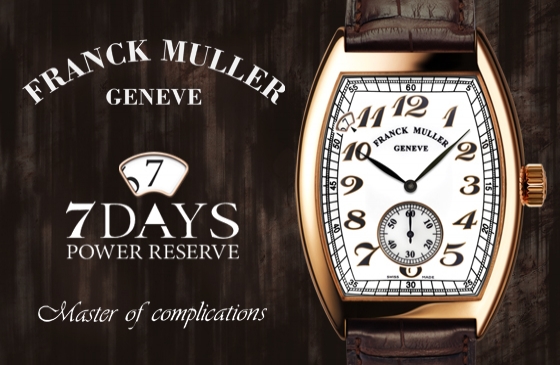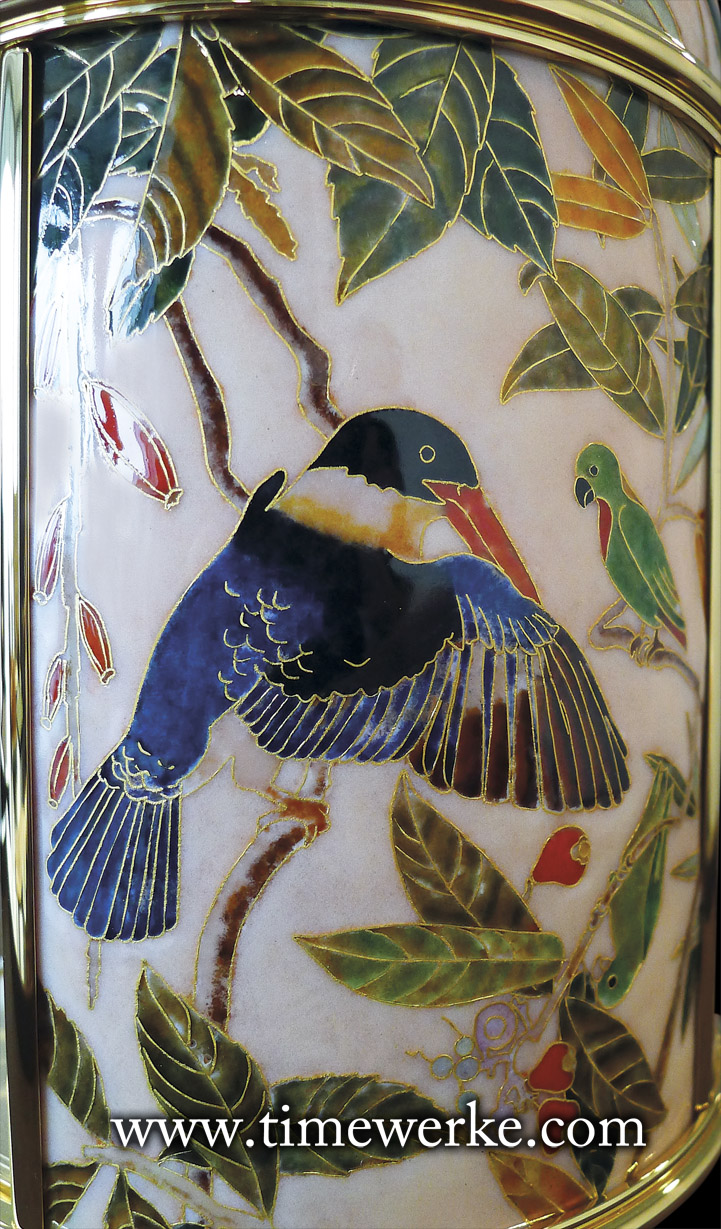
Taking its inspiration from illustrations found in the William Farquhar Collection of Natural History Drawings is Patek Philippe’s “Farquhar Collection” Ref. 1675M dome clock. One main feature on the side of this dome table clock is the Black-capped Kingfisher / Pekaka kopiah hitam / Halcyon pileata, described as a migratory species and a fairly common visitor on the Malay Peninsula from the breeding grounds further north and in sub-tropical and temperate East Asia. On its right (and referenced from another drawing) are a pair of Blue-crowned hanging parrots / Burung serindit / Loriculus galgulus. The male is perched upright and has a red bib while the female beneath it is about to feed on water apple fruits. Measuring no more than 12cm from the tip of its bill to its tail, this is one of the smallest parrots in the world. It is fairly common throughout forests in Malaysia and Singapore but is difficult to spot as is normally found high up in the canopies of large trees. Text referenced from Natural History Drawings: The Complete William Farquhar Collection, Malay Peninsula 1803 – 1818. Photo: © TANG Portfolio. Elfa / Timmy. 2015
In 2015, Patek Philippe created three one-of-a-kind dome table clocks to commemorate the 50th anniversary of Singapore’s independence (1965 to 2015).
One of the dome clocks is the Ref. 1675M “Farquhar Collection” which takes its inspiration from the famed William Farquhar Collection of natural history drawings, as its name implies.
William Farquhar (1774 to 1839) was the first British Resident and Commandant of Singapore from 1819 to 1823. An emissary of Sir Thomas Stamford Raffles (1781 to 1826), Farquhar was part of the British negotiating team for the Singapore Treaty that led to the establishment of the British settlement and trading post on the island.
Those familiar with Farquhar’s watercolour prints will easily recognise not one but many illustrations, mostly of birds, this time meticulously reproduced using the art of cloisonné enamel on the Patek Philippe “Farquhar Collection” Ref. 1675M dome clock.
The other two are the Ref. 1665M “Peranakan Culture” dome clock and the Ref. 1677M “The Esplanade – Singapore” dome clock.
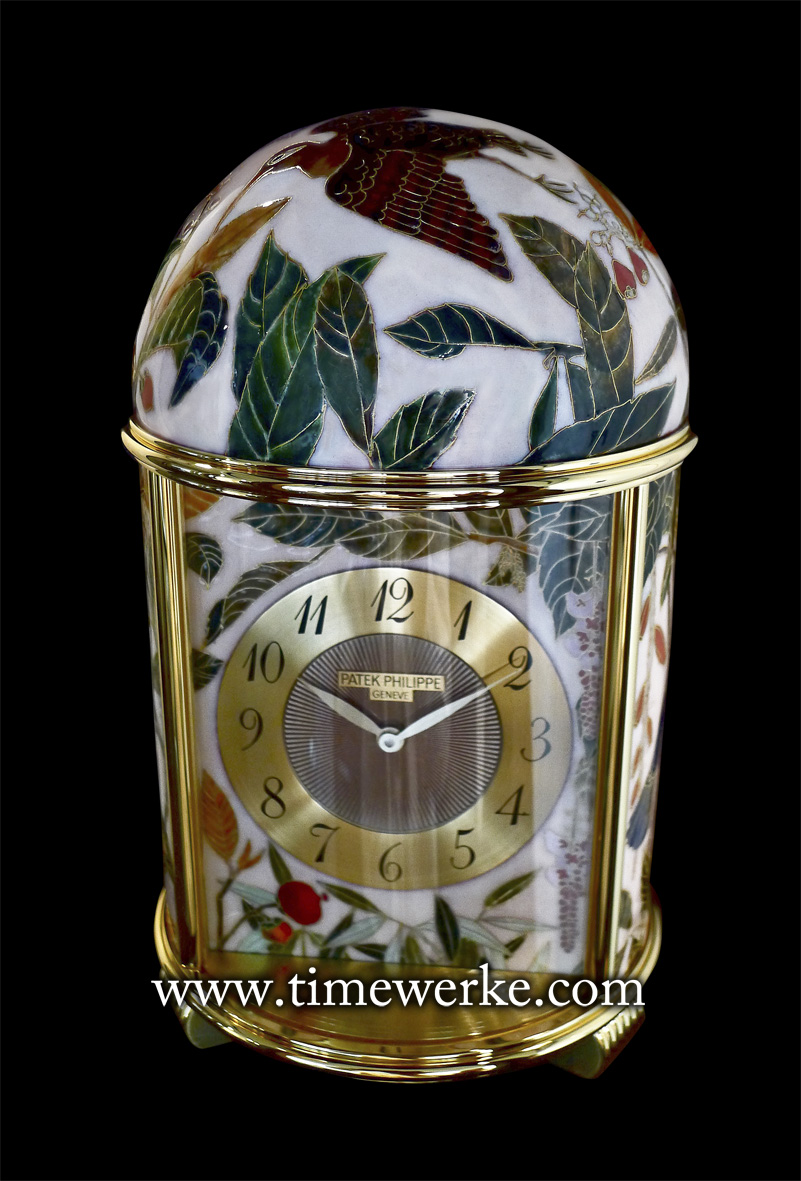
Patek Philippe “Farquhar Collection” Ref. 1675M dome table clock in cloisonné enamel. Pièce unique made in 2015 to commemorate the 50th anniversary of Singapore’s independence (1965 to 2015). This one-of-a-kind Patek Philippe dome clock was inspired by the William Farquhar Collection of Natural History Drawings which comprises 477 watercolour illustrations of flora and fauna in the Malay Peninsula region. The drawings, commissioned by Farquhar, were made between 1803 and 1818 by Chinese artists. To reproduce the selected historical natural history drawings, the enameller used transparent opaque and opalescent enamels in 78 colours. Tracing the outlines required 32.55 metres of gold wire (weighing 65.1 grams) measuring 0.2mm in diameter. Each enamelled element had to be fired between eight and fourteen times at temperatures of around 930 degrees Celsius. The hour circle is adorned with black enamelled Breguet numerals and frames a silver dial centre guillochéd with sand-coloured enamel. Height of the dome clock: 213.5mm. Reserve auction price: SGD270,000. Sold for: SGD1 million on 23 September 2015 with the entire proceeds going to the National Museum of Singapore. Photo: © TANG Portfolio. Elfa / Timmy. Singapore September 2015
All three dome clocks were put up for auction during a private dinner held on 23 September 2015 whereby only those attending could make bids.
The good news was that the total of SGD2.45 million were raised with the Ref. 1675M “Farquhar Collection” securing the highest sale price of SGD1 million. This meant that this dome clock alone accounted for around 40% of the total proceeds raised.
The even better news – the dome clocks were donated by Patek Philippe with the entire sales proceeds raised being given to museums and charitable organisations. For example, the SGD1 million from the sale of the Ref. 1675M “Farquhar Collection” will go the National Museum of Singapore – the custodian of the William Farquhar Collection.
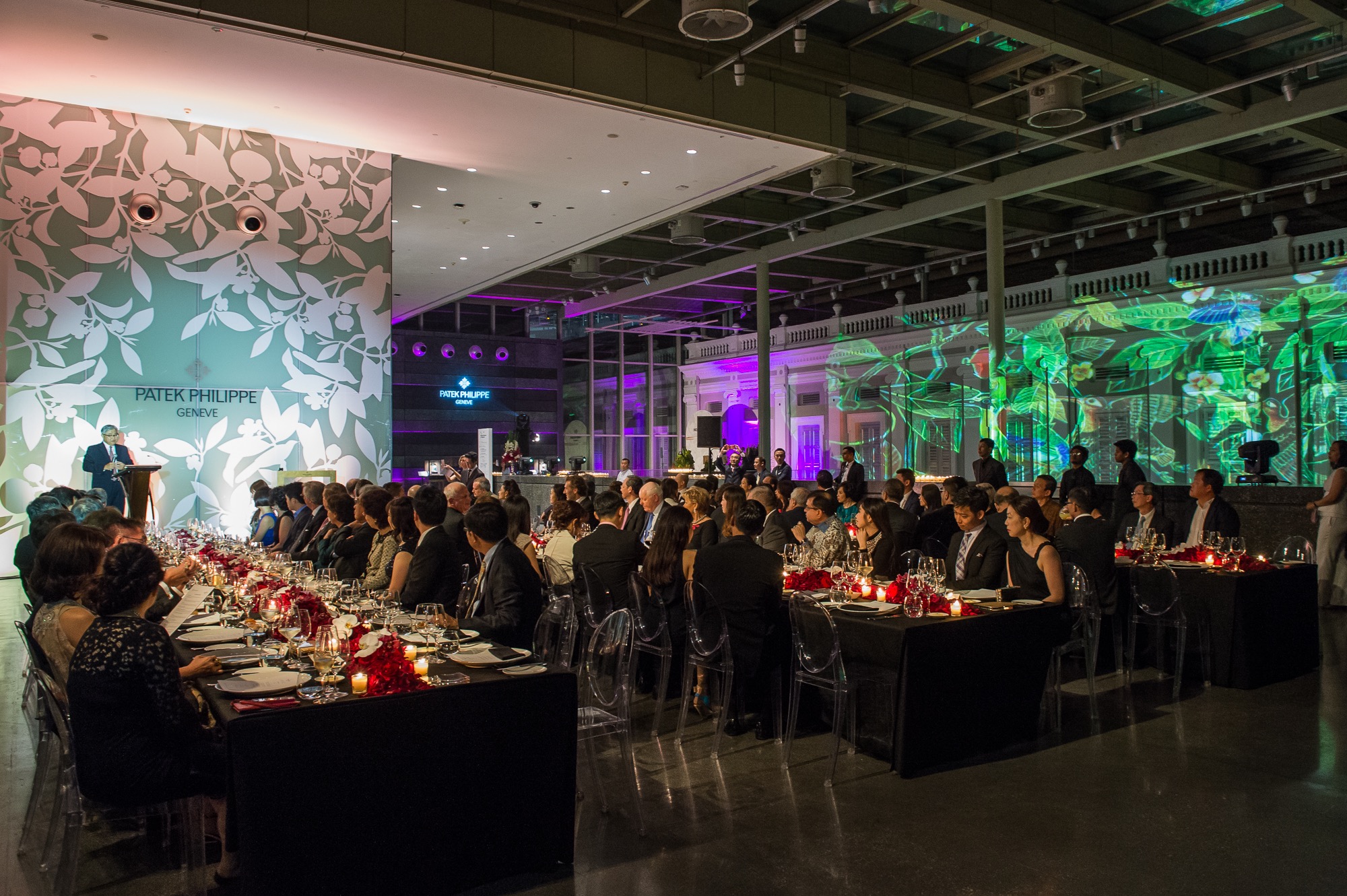
During a private Patek Philippe dinner held on 23 September 2015 at the Flutes restaurant at the National Museum of Singapore (seen above), a closed-door auction was held whereby only those present could bid for the three commemorative Patek Philippe dome clocks celebrating the 50th anniversary of Singapore’s independence – the Ref. 1665M “Peranakan Culture” dome clock, the Ref. 1675M “Farquhar Collection” and the Ref. 1677M “The Esplanade – Singapore” dome clock. Philippe Stern, honorary president of Patek Philippe was present. Thanks to the generosity of Patek Philippe and their special guests, a total of SGD2.45 million was raised for very meaningful objectives. Photo: courtesy of Patek Philippe. Singapore September 2015
The Ref. 1677M “The Esplanade – Singapore” dome clock fetched SGD750,000 (with proceeds earmarked for the “Heritage Cares” program for beneficiaries of Singapore Comchest) while the Ref. 1665M “Peranakan Culture” was sold for SGD700,000 (with proceeds going to the Peranakan Museum).
The Singapore theme is naturally a common denominator for the three magnificent dome clocks. While the brand states that each captures the quintessence of Singapore, whether its past or present, its flora and fauna, culture and heritage or even modern landscape, we would like to take this further and deeper.
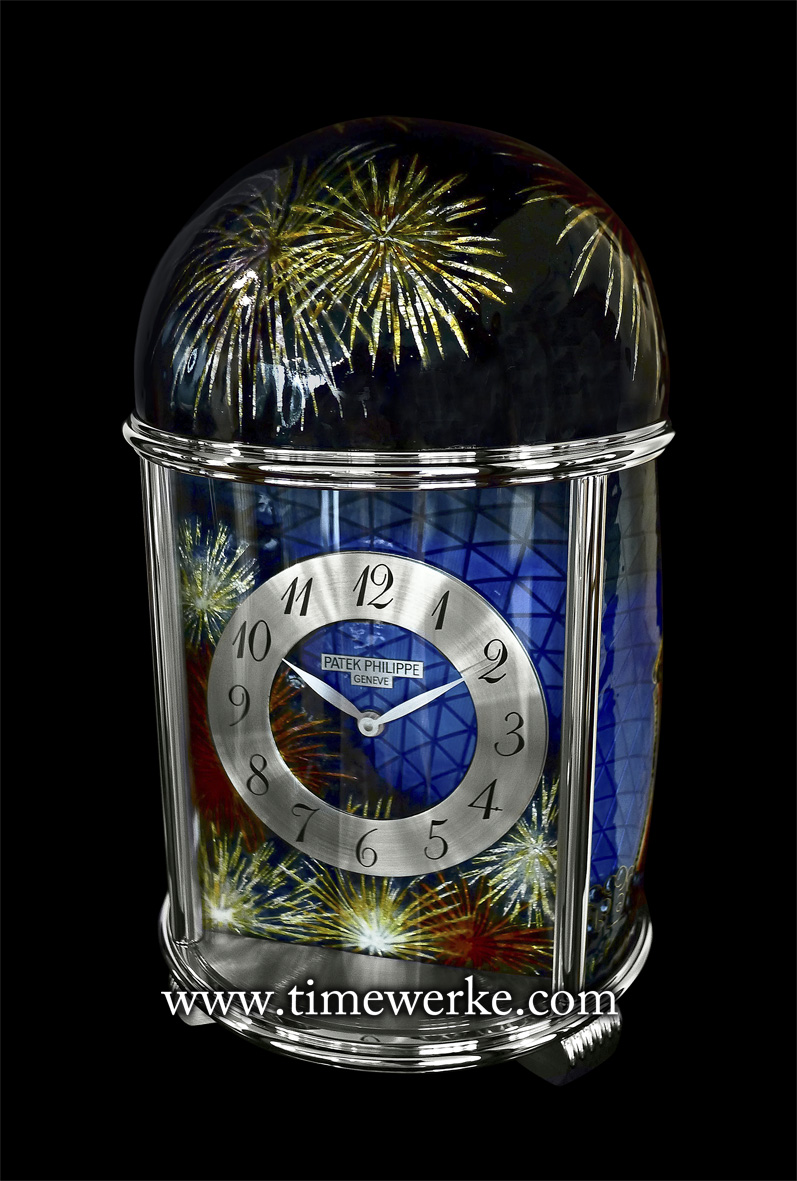
Patek Philippe “The Esplanade – Singapore” Ref. 1677M dome table clock hand-guillochéd in cloisonné enamel with silver leaf. Made in 2015 to commemorate the 50th Anniversary of Singapore’s Independence (1965 to 2015). This pièce unique presents the panoramic view of Singapore’s skyline featuring popular landmarks including the Singapore River. These include Marina Bay Sands, the Singapore Flyer and the ArtScience Museum under a night sky lit up by fireworks. The artist had to hand-guilloché the silver panels forming the dial and body of the clock to reproduce the geometric patterns of the buildings. To have the skyline and towers depicted, 6.25 metres of gold wire (weighing 12.5g) measuring 0.2mm in diameter and some 20 enamel colours were required. Most of the colours were transparent with a few opalescent tints and one opaque shade. There are inclusions of silver leaves beneath the translucent enamel to conjure up the glow of fireworks, the glitter of the cityscape and the sparkle of light on water. Each enamelled element required 11 firings at temperatures ranging from 810 degrees Celsius to 920 degrees Celsius. The hour circle is adorned with black enamelled Breguet numerals. Height of the dome clock: 213.5mm. Reserve auction price: SGD300,000. Sold for: SGD750,000 on 23 September 2015 with the entire proceeds going to the :Heritage Cares” program for beneficiaries of Singapore Comchest. Photo: © TANG Portfolio. Elfa / Timmy. Singapore September 2015
On the surface, it seems obvious with what is stated as Singapore’s flora and fauna as depicted on the Ref. 1675M “Farquhar Collection” dome clock, Singapore’s Peranakan culture and heritage represented by the Ref. 1665M “Peranakan Culture” dome clock as this country was once part of the British-controlled Straits Settlements where many Peranakans were born, and the current Singapore skyline as seen on the Ref. 1677M “The Esplanade – Singapore” dome clock where major landmarks like the Marina Bay Sands and Singapore Flyer are featured.
Peranakans are generally described as the descendants of early Chinese immigrants who married natives of the Malay Archipelago and Bataks from Sumatra. They are also known as the Straits Chinese, having been born in the then British-controlled Straits Settlements covering Singapore, Penang and Malacca.
[Note: For more information on Peranakans and the “Peranakan Culture” dome table clock, do reference a related article: Patek Philippe Ref. 1665M “Peranakan Culture” dome table clock: Vibrant Flower Power.]
What must be noted is that Farquhar’s natural history drawings of flora and fauna were not unique to Singapore; they comprise watercolour drawings of what was observed and discovered in the region – the Malay Peninsula that Singapore is a part of.
Bear in mind that these watercolour artworks were painted in Malacca between 1803 and 1818 and not during the time when Farquhar was responsible for the administration of Singapore.
For us, the main link for all three dome clocks to Singapore is actually William Farquhar who was the first Resident and Commandant of Singapore from 1819 to 1823.
While not as well-known in history as Raffles, Farquhar’s contributions in the early development of Singapore should not be overlooked and must be recognized. Do not forget that in 1819, he assisted in the negotiations to set up the first British post on this island as well.
Farquhar was responsible for clearing land along the Singapore River back then. He also made Singapore an attractive place for people to trade and settle in. Granted, he “disobeyed” orders from Raffles and even allowed gambling dens to thrive but one must also look at the other side of the coin and perhaps allow him some slack for adopting a pragmatic approach given his limited resources. After all, Singapore quickly thrived under his administration (by around 1820).
Fast forward 200 years later and thankfully, Singapore today is still a thriving economy. The development along the Singapore River has evolved but remains an important area and this now includes the reclaimed land nearby.
What has sprouted up include the Marina Bay Sands, the ArtScience Musuem and the Singapore Flyer, key attractions for both local and foreign visitors and major landmarks depicted on the dome clock.
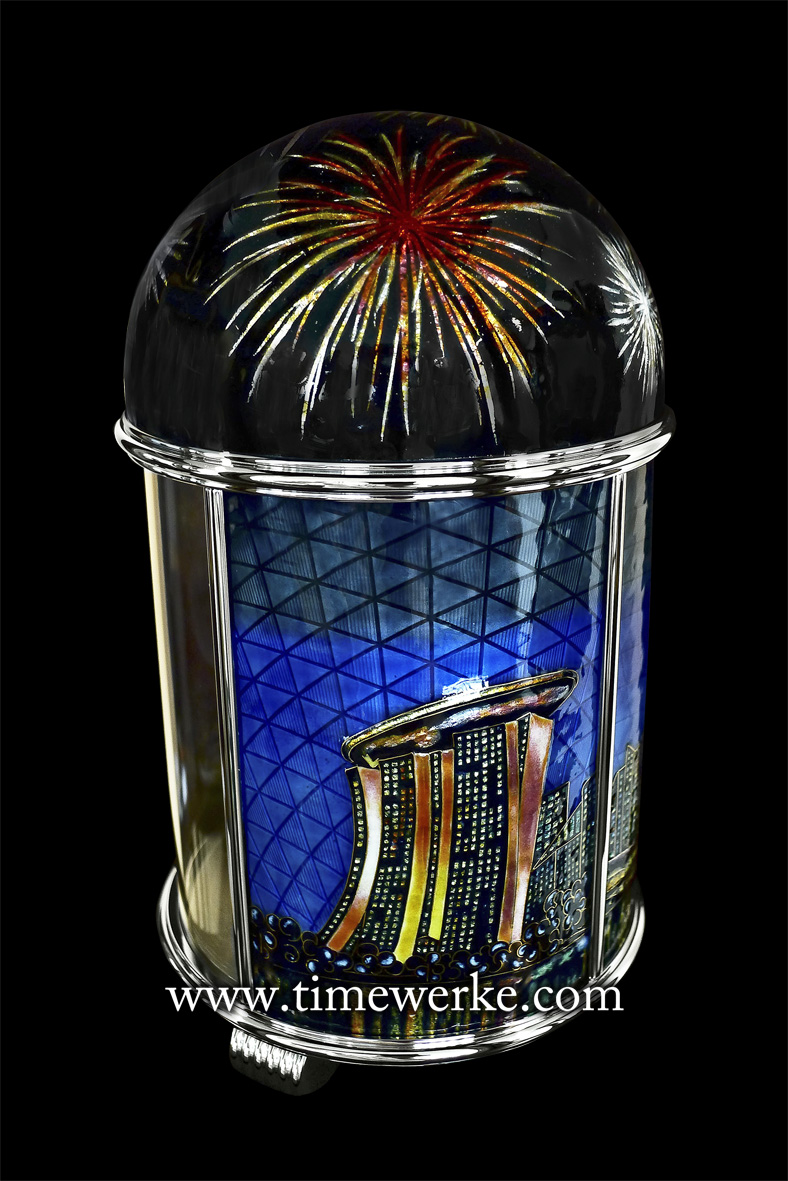
Marina Bay Sands which is featured on the Patek Philippe “The Esplanade – Singapore” Ref. 1677M dome clock is a popular landmark in Singapore and it opened in April 2010. In 2005, the Marina Bay site itself was priced at SGD1.2 billion by the Singapore government and Las Vegas Sands, whose chairman and chief executive officer is Sheldon Adelson, secured the rights in May 2006. The top of the dome shows a display of fireworks. Photo: © TANG Portfolio. Elfa / Timmy. Singapore September 2015
Therefore, there is, in a sense, the Farquhar link to the modern Singapore skyline and hence, the Ref. 1677M “The Esplanade – Singapore” dome clock.
Farquhar’s collection of natural history drawings is not just a great reminder of his scientific activities but his contribution to mankind’s understanding of the flora and fauna in Southeast Asia, the Malay Peninsula in particular.
Moreover, it goes beyond that; it is also symbolic of a gentleman who was instrumental in the early development of Singapore. After all, it is through this William Farquhar Collection that was acquired by Goh Geok Khim who subsequently donated it to the National Museum of Singapore that even more people have begun to sit up and take notice of Farquhar and the role he played in Singapore’s history.
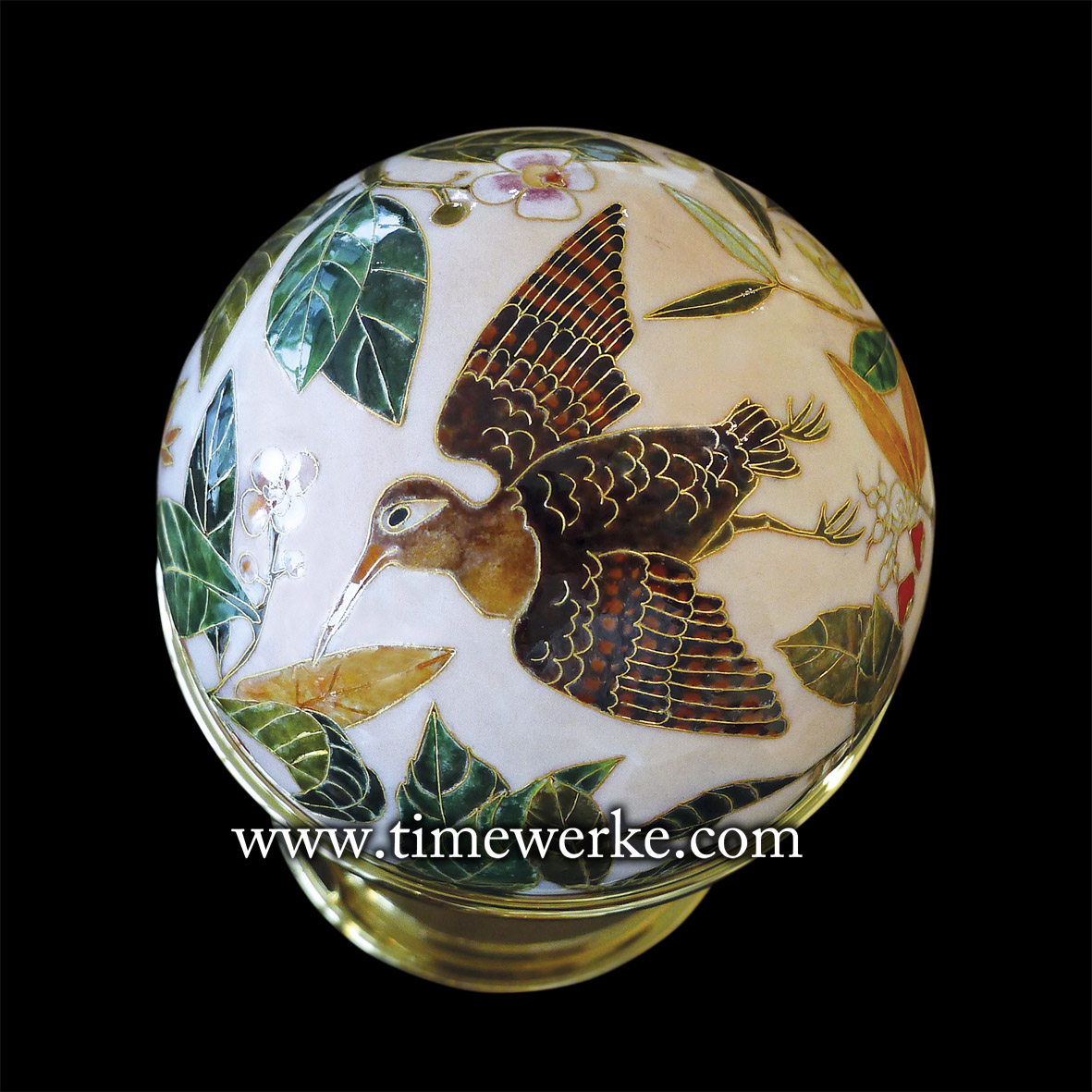
From a top-down perspective of the Patek Philippe “Farquhar Collection” Ref.1675M dome clock, you will have a view of this bird which we believe is inspired by the drawings of the Greater painted-snipe / Burung Meragi / Rostratula benghalensis from the William Farquhar Collection. In that drawing, there are actually three birds depicted, the flying bird as seen above is the male greater painted-snipe water bird. What is not seen or decorated on the dome clock is its female companion that is walking in the actual drawing and another bird, the migratory terek sandpiper, Xenus cinereus. There are two points that we can highlight with this flying bird in cloisonné enamel. Firstly, you can easily make out the outline of the bird and it is done using a gold wire. In total, the outlines traced of the birds, leaves, flowers and even a butterfly on the Ref. 1675M “Farquhar Collection” dome clock required 32.55 metres of gold wire with a diameter of 0.2mm. The weight of the gold used amounted to 65.1 grams. Secondly, this is perhaps an example of the “stiffness and flatness” of a drawing in the William Farquhar Collection alluded to by Kwa Chong Guan in his authoritative article, Drawing Nature in the East Indies: Framing Farquhar’s Natural History Drawings, but he balances this objective critique by adding that these (stiffness and flatness) only add to the interest and appeal of the drawings. Photo: © TANG Portfolio. Elfa / Timmy. Singapore September 2015
Without the William Farquhar Collection of natural history drawings, Farquhar may well have been forgotten and the thought of how he could well be one of Singapore’s “founders” will not even be worthy of any discussion today.
Yes, Farquhar was dismissed in 1823, but as noted by John Bastin in his authoritative article William Farquhar: First Resident and Commandant of Singapore, “Contrary to what has been written about him, Farquhar appears in his roles as Resident and Commandant of Melaka (Malacca) between 1803 and 1818, and of Singapore between 1819 and 1823, as a benevolent ruler, sympathetic to the interests of the people under his charge, and energetic in confronting the formidable problems of his complex administrations”.
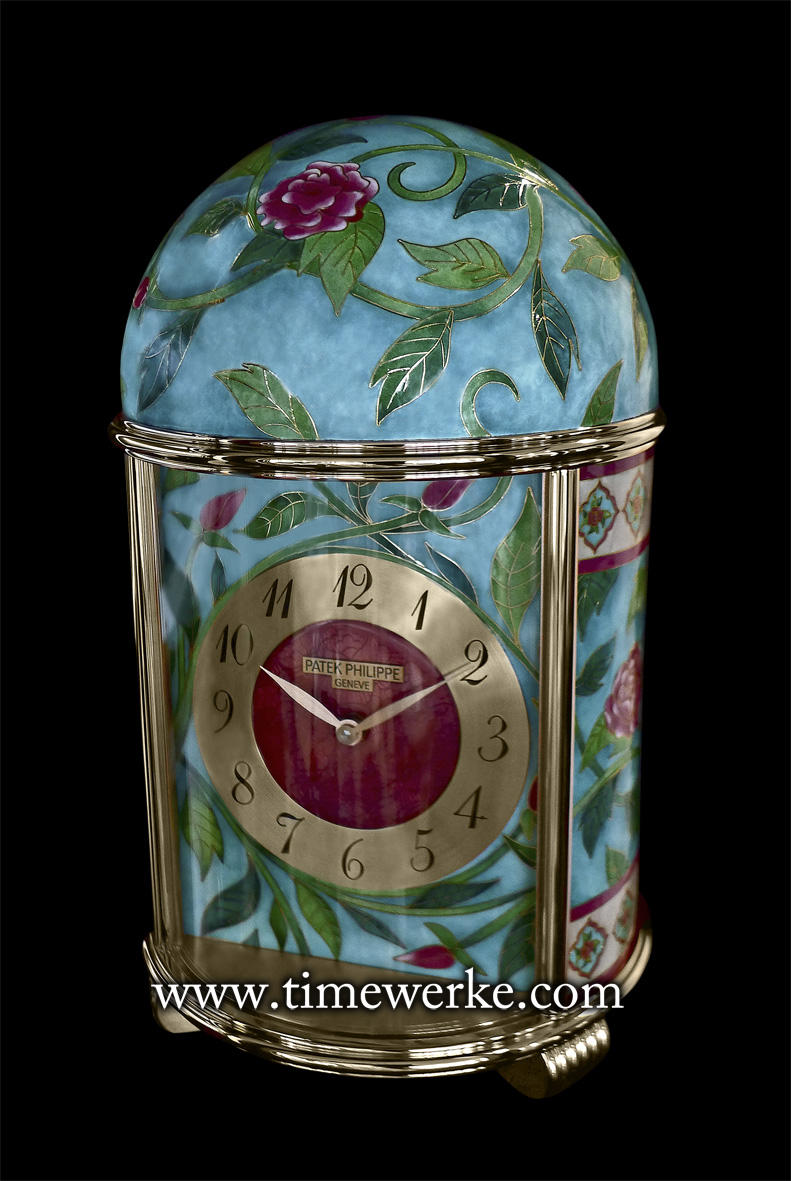
Patek Philippe “Peranakan Culture” Ref. 1665M dome table clock in cloisonné enamel commemorating the 50th anniversary of Singapore’s independence (1965 to 2015). More than 28 metres of gold wire weighing 53.5 grams were required for this one-of-a-kind piece. This Ref. 1665M dome table clock is the very first third series Patek Philippe dome clock that is in rose gold. Reserve auction price: SGD250,000. Sold for: SGD700,000 on 23 September 2015 with the entire proceeds going to the Peranakan Museum. Photo: © TANG Portfolio. Elfa / Timmy. Singapore September 2015
Now what is the link between Farquhar and the Ref. 1665M “Peranakan Culture” dome clock? Apparently, while in Asia, Farquhar had either married or cohabited with a woman known as Nonio Clement or Clemaine from Malacca who was of French-Malay descent and they had six children.
The daughter of a French officer and an Asian mother, her name “Nonio” is said to be another form of the word “Nonya”. Could she well have been Peranakan as well? After all, female Peranakans are called nonyas or nyonyas while males are known as babas.
If so, then this is the link between Farquhar and the Ref. 1665M “Peranakan Culture” dome clock.
Note: After Farquhar returned to London, he married Margaret Loban and they had six children.
Interestingly, based on early indications, it seemed that the two highly desired dome clocks were actually the Ref. 1667M “The Esplanade – Singapore” dome clock and the Ref. 1665M “Peranakan Culture” dome clock.
The Ref. 1665M “Peranakan Culture” dome clock had another plus point in its favour: it is the first one in rose gold for a Patek Philippe third series dome clock, highlights John Reardon, senior vice president, international head of watches, Christie’s.
The fact that the Patek Philippe Ref. 1675M “Farquhar Collection” dome clock emerged as the dearest at SGD1 million during the closed door auction perhaps speaks volumes. All three dome table clocks are recognised for the artistry and high craftsmanship, but perhaps the Ref. 1675M “Farquhar Collection” dome clock struck a more emotional chord with some for its deep historical, cultural and symbolic significance.
And for another million-dollar consideration, since the old road honoring Singapore’s first Resident and Commandant was expunged in 1994, perhaps it is also time for to consider having a new one in Singapore named after Farquhar?
Another related article on timewerke.com which we highly recommend is:
i. Patek Philippe Ref. 1665M “Peranakan Culture” dome table clock: Vibrant Flower Power.


